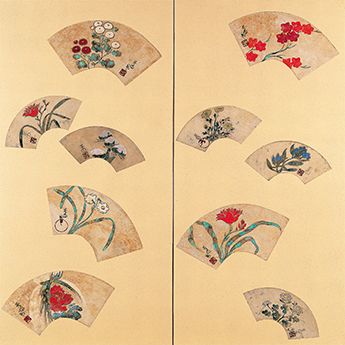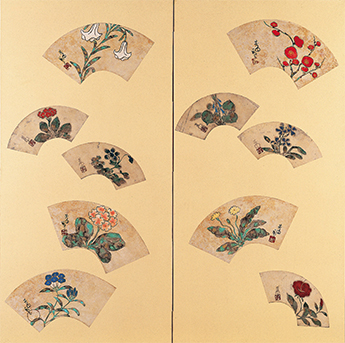Curators’ selection — Hidden Masterpieces
NAKAMURA Hochu, Flowers and Plants of the Four Seasons, Edo period, Early 19th century, Color on paper
NAKAMURA Hochu, Flowers and Plants of the Four Seasons, Edo period, Early 19th century, Color on paper
At this time of year, despite the piercingly cold air, we may detect a delicately fragrant scent. The plum tree, blooming in the cold, leads the way for the many other flowers. The plum and its blossoms have long been celebrated in poems and paintings.
In this painting, the plum tree’s gently curving branches and its rounded flowers contrast with our image of the plum tree blooming with dignity during intense cold.Together, they give it a charming, tender atmosphere. The artist’s soft, tilted signature, on the left-hand side, provides the final touch for the gentle world created in this painting.
This painting is by Nakamura Hochu (? - 1819), an artist who was active in the mid-Edo period, principally in Osaka.
An Edo-Period Artist?
Does it seem rather strange that I am introducing an Edo-period work? The Ishibashi Foundation Collection, is, after all, known for its modern, and especially Impressionist, art. But the collection includes not only modern painting and sculpture from the West and modern Japanese Western-style painting but also classic Japanese and Chinese calligraphy and painting as well as ceramics and glass from the Middle East. Until recently, the works in the collection other than modern art were displayed at the Ishibashi Museum of Art in Kurume, Fukuoka Prefecture. In October, 2016, however, our collection was consolidated; from now on, it will all be exhibited at the Artizon Museum. It will take some time, however, for the new museum building to be completed. Meanwhile, we would like to introduce these paintings, which have only been shown in Tokyo once—hidden masterpieces from our collection.
Related works are also presented on the Collection page of this website; be sure to take a look at them.
Asian Antiques
To return to this work: The plum blossom painting is one of a collection of fan paintings of flowers, including dandelions, lilies, gentians, and daylilies, all pasted on a pair of two-panel folding screens (fig. 1). The plum is at the upper right. The seasons unfold to its left: spring, summer, fall, winter. Upon closer inspection, we notice that the screens include larger and smaller fan paintings, ten of each type. Those paintings had each been handed down separately; it was only immediately before they became part of the Ishibashi Foundation Collection that they were brought together on these folding screens. In each botanical subject, the flower is rendered with a broad outline in pale sumi black, as in the plum blossoms examined above. The horinuri (“painting-by-carving”) technique is used to apply color, leaving gaps between it and the flower’s outline. The branches, stalks, and leaves are rendered without outlines, using the tarashikomi (“dripping in”) technique, layering ink or pigment on surface areas still wet with paler ink or colors, to create a running, pooling effect in sumi ink and pale green and gold pigments. The plants and flowers extend their branches and leaves as though in response to the shape of the picture plane, which opens out from base to top in a gentle arc. With this enigmatic expression of their life force, which could be interpreted as vigorous or perhaps rather weary, Hochu creates his unique artistic universe.
In this painting, the plum tree’s gently curving branches and its rounded flowers contrast with our image of the plum tree blooming with dignity during intense cold.Together, they give it a charming, tender atmosphere. The artist’s soft, tilted signature, on the left-hand side, provides the final touch for the gentle world created in this painting.
This painting is by Nakamura Hochu (? - 1819), an artist who was active in the mid-Edo period, principally in Osaka.
An Edo-Period Artist?
Does it seem rather strange that I am introducing an Edo-period work? The Ishibashi Foundation Collection, is, after all, known for its modern, and especially Impressionist, art. But the collection includes not only modern painting and sculpture from the West and modern Japanese Western-style painting but also classic Japanese and Chinese calligraphy and painting as well as ceramics and glass from the Middle East. Until recently, the works in the collection other than modern art were displayed at the Ishibashi Museum of Art in Kurume, Fukuoka Prefecture. In October, 2016, however, our collection was consolidated; from now on, it will all be exhibited at the Artizon Museum. It will take some time, however, for the new museum building to be completed. Meanwhile, we would like to introduce these paintings, which have only been shown in Tokyo once—hidden masterpieces from our collection.
Related works are also presented on the Collection page of this website; be sure to take a look at them.
Asian Antiques
To return to this work: The plum blossom painting is one of a collection of fan paintings of flowers, including dandelions, lilies, gentians, and daylilies, all pasted on a pair of two-panel folding screens (fig. 1). The plum is at the upper right. The seasons unfold to its left: spring, summer, fall, winter. Upon closer inspection, we notice that the screens include larger and smaller fan paintings, ten of each type. Those paintings had each been handed down separately; it was only immediately before they became part of the Ishibashi Foundation Collection that they were brought together on these folding screens. In each botanical subject, the flower is rendered with a broad outline in pale sumi black, as in the plum blossoms examined above. The horinuri (“painting-by-carving”) technique is used to apply color, leaving gaps between it and the flower’s outline. The branches, stalks, and leaves are rendered without outlines, using the tarashikomi (“dripping in”) technique, layering ink or pigment on surface areas still wet with paler ink or colors, to create a running, pooling effect in sumi ink and pale green and gold pigments. The plants and flowers extend their branches and leaves as though in response to the shape of the picture plane, which opens out from base to top in a gentle arc. With this enigmatic expression of their life force, which could be interpreted as vigorous or perhaps rather weary, Hochu creates his unique artistic universe.


- fig.1
- NAKAMURA Hochu, Flowers and Plants of the Four Seasons, Edo period, Early 19th century, Color on paper

